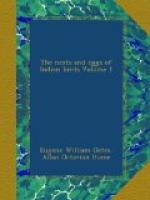It appears to lay from April to the end of August. The nest of this species, though perhaps slightly deeper, is very much like that of O. kundoo; it is a deep cup, carefully suspended between two twigs, and is composed chiefly of tow-like vegetable fibres, thin slips of bark and the like, and is internally lined with very fine tamarisk twigs or fine grass, and is externally generally more or less covered over with odds and ends, bits of lichen, thin flakes of bark, &c. It is slightly smaller than the average run of the nests of O. kundoo. The egg-cavity measures about 3 inches in diameter and nearly 2 inches in depth. I myself have never found more than three eggs, but I daresay that, like O. kundoo, it may not unfrequently lay four.
The late Captain Beavan writes:—“A nest with three eggs, brought to me in Manbhoom on 5th April, 1865, is cup-shaped; interior diameter 3.5, depth inside 2 inches. It is composed outside of woolly fibres, flax, and bits of dried leaves, and inside of bents and small dried twigs, the whole compact and neat. The eggs are of a light pink ground (almost flesh-coloured), with a few scattered spots of brownish pink, darker and more numerous at the blunt end. They measure 1.125 by barely 0.8.”
From Raipoor, Mr. F.R. Blewitt remarks:—“Oriolus melanocephalus indiscriminately selects the mango, mowah, or any other kind of large tree for its nest, which is invariably firmly attached to the extreme terminal twigs of an upper horizontal branch, varying from 20 to 35 feet from the ground. Owing to the position it selects for the safety of its nest, it sometimes happens that the latter cannot be secured without the destruction of the eggs. It nidificates in June and July, and it would appear that both the birds, male and female, engage in the construction of the nest. Three is the normal number of the eggs, though on one occasion my shikaree found four in a nest.”
Buchanan Hamilton tells us that this species “frequents the groves and gardens of Bengal during the whole year, and builds a very rude nest of bamboo-leaves and the fibres that invest the top of the cocoanut or other palms. In March I found a nest with the young unfledged.”
I confess that I believe this to be a mistake: neither season nor nest correspond with what I have myself seen about Calcutta. The nests, so far from being rude, are very neat.
Mr. J.R. Cripps writes from Furreedpore in Eastern Bengal:—“Very common, and a permanent resident. On the 20th April I found a nest containing two half-fledged young ones; in the garden was a clump of mango-trees, and attached to one of the outer twigs, but overhung by a lot of leaves, and about 12 feet from the ground, hung the nest, of the usual type.”
Mr. J. Davidson met with this Oriole on the Kondabhari Ghat in Khandeish. On the 16th August he saw a brood, while on an adjoining tree there was a nest with two slightly-set eggs. He says:—“It was a very deep cup on the end of a thin branch, and though in cutting the branch to get at the nest, it got turned at right angles to its proper position, the eggs were uninjured. I do not think this nest belonged to the same pair as that which had young ones flying.




